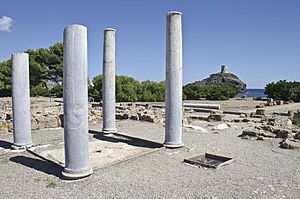Nora, Italy facts for kids

The ancient ruins of Nora, with a Spanish tower in the background.
|
|
| Lua error in Module:Location_map at line 420: attempt to index field 'wikibase' (a nil value). | |
| Type | Settlement |
|---|---|
| History | |
| Cultures | Phoenician civilization Roman civilization |
| Site notes | |
| Excavation dates | yes |
| Condition | ruined |
| Management | I Beni Culturali della Sardegna |
| Public access | yes |
| Website | Pula, area di Nora |
Nora is an ancient town located on a small peninsula near Pula in Sardinia, Italy. It was once a busy place, first settled by people before the Romans, and then becoming an important Roman city. Today, you can visit its amazing ruins and imagine what life was like thousands of years ago.
Contents
The Story of Nora
How Nora Was Founded
Long ago, a Greek writer named Pausanias shared a legend about Nora. He said that the city was founded by a leader named Norax. Some believe Norax was the son of the god Hermes. Another writer, Solinus, wrote that the city was named Nora after Norax.
Early Life in Nora
At first, a local Sardinian village lived here. Soon, Nora became a busy trading post, a place where people bought and sold goods. Later, it grew into a Phoenician city.
Nora became very important, especially after Carthage took control. It was the first stop on the sea route from Carthage to Sardinia. Cagliari, a major city in Sardinia, was also very important.
The Nora Stone
In 1773, a special stone was found in Nora. It is called the Nora Stone. This stone has writing in the Phoenician language. Experts believe it was carved between the late 9th century and early 8th century BC. The writing on the stone seems to talk about a Phoenician army winning a battle and taking over the area.
Roman Rule and Decline
After being ruled by Carthage for a while, Nora came under Roman control in 238 BC. This happened after the Romans conquered Sardinia. The city is even mentioned on an old Roman map called the Tabula Peutingeriana.
Nora began to decline around the mid-5th century AD. This was after the Vandals, a Germanic tribe, conquered Sardinia. The Eastern Romans later took over the island in 535 AD and ruled it for 300 years.
After the Arabs conquered Carthage in 698 AD, Nora lost its importance as a trading city. It became just a simple fort. Nora seems to have been completely abandoned during the 8th century.
Exploring the Ruins
Nora's Underwater Secrets
A large part of Nora is now under the Mediterranean Sea. This is because the southern part of Sardinia is slowly sinking. Another nearby ancient town, Bithia, is now completely underwater.
What You Can See Today
Nora was a very important trading town in its time. It had two protected harbours, one on each side of the peninsula. You can see different building styles in the excavated ruins, showing how the city changed over time.
The ancient ruins of Nora are like an open-air museum. You can see the remains of a Roman theatre. Sometimes, concerts are held there in the summer. A large part of the town is still unexcavated because it is on land belonging to the Italian Army.
Images for kids
See also
 In Spanish: Nora (Cerdeña) para niños
In Spanish: Nora (Cerdeña) para niños


